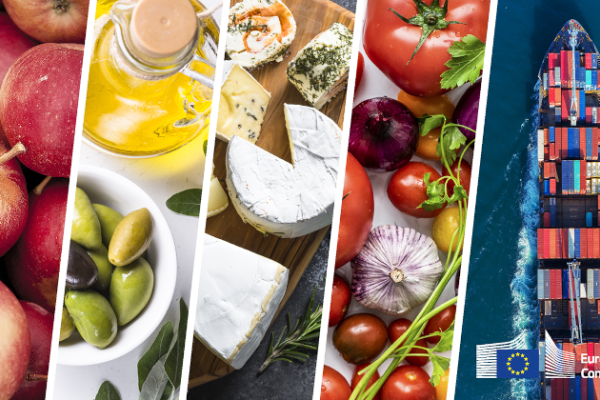
The value of EU agri-food trade reached a total of €31.4 billion in April 2022, an increase of 14% compared to April last year. Exports of agri-food products declined by 5.4% month to month, largely due to reduced exports to Russia (-26%) and China (-11%). Imports of agricultural products reached a value of €13.5 billion (1.2% lower than March), giving a total agri-food trade balance of €4.4 billion for April 2022. This is a decrease of 16% compared to March of this year.
Overall, trade flows for January-April 2022 are significantly higher than the same period last year, with exports and imports increasing by 10% and 28% respectively due to high global prices. These figures were published today in the European Commission's latest monthly agri-food trade report.
Monthly trade developments in April
Notable month to month increases were seen in exports to Ukraine and sub-Saharan Africa. To Ukraine, there was a 93% increase compared to March, with particularly strong growth in exports of pigmeat, poultry, and flour and flakes. Growth in exports to sub-Saharan Africa was seen in oilseeds (+83% in volumes), cereals (+27%) and cereal preparations (+14%).
There was a significant decline in monthly imports from the UK and China. The reduction in imports from the UK came mainly from a decrease in quantities of spirits and liqueurs (-19%), confectionary and chocolate (-24%) and cereal preparations and milling products (-17%). Imports from China decreased in virtually all categories, with the most notable of these being oilseed and protein crops (-69% in volumes), and coffee, tea, cocoa and spices (-25%).
Following Russia’s invasion of Ukraine, maize imports from Ukraine fell dramatically in March and April (-35% year on year), as did those from Serbia (-77%). Maize imports from the US, Canada, Moldova and Brazil have partially compensated for this disruption to the supply chain.
Trade developments year on year
Agri-food exports to the UK, US and Japan have all grown in the first four months of the year, with exports to Russia, China and Ukraine declining. Exports to the UK increased by 20% in the first quarter of 2022, compared to particularly depressed levels in the same period last year.
This was driven by a sharp increase in export volumes of butter (+69%), wheat (+25%) and maize (+46%). With an increase in prices, export values of cereal preparations and milling products, and poultry and eggs, increased by EUR 280 000 and EUR 270 000 respectively.
Separately, the value of exports to China fell by EUR 2 billion compared to 2021. This is primarily due to a sizeable reduction in exports of pigmeat, which have fallen by a value of EUR 1.9 billion. Rape oil exports have also decreased by a value EUR 156 000. Despite this, exports of cereal preparations and wheat to China have increased.
Regarding specific product categories, export values of cereals grew most in the first four months of the year, increasing by 26% or EUR 1 million. Cereal preparations and milling products (+15%) and dairy products (+13%) also saw notable growth. Exports of pigmeat and horticulture, however, fell, by 24% and 3% respectively. This was due to the continued reduction in demand for pigmeat exports to China, and reduced demand for horticulture products in the UK and Russia.
Imports in the January-April period grew most from Brazil (+46%), the UK (+43%) and China (+65%). The highest absolute increase was seen in imports from Brazil, which grew by almost EUR 1.7 billion. This was due to strong growth in imports of soya beans and meals, and coffee, which had cumulative import values of EUR 2.5 billion and EUR 1.4 billion respectively.
The EU imports most of its coffee from Brazil, Vietnam and Uganda. While EU import values for coffee increased by 62%, volumes only rose by 4%. Separately, imports from Australia have almost doubled to reach a value of EUR 1.4 billion, primarily due to imports of rapeseed, and wool and silk.
More insights as well as detailed tables are available in the latest edition of the monthly EU agri-food trade report.
More information

Details
- Publication date
- 28 July 2022
- Author
- Directorate-General for Agriculture and Rural Development
- Location
- Brussels



